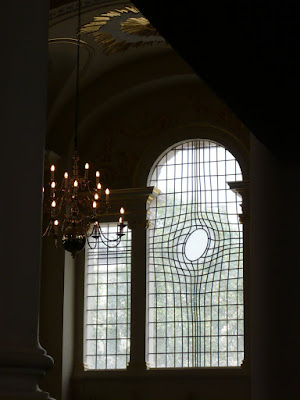
8.30am Breakfast and registration.
10.45am Break
11.00am Repeat of Breakout groups
12.00noon Panel session with panellists: Saif Ahmad, Jay Lakhani, Alison Murdoch and Ed Newell.
12.40pm Keynote speech – Jay Lakhani
1.00pm Lunch

 Rodney Bailey with a piece included in the staff exhibition at the V&A
Rodney Bailey with a piece included in the staff exhibition at the V&A
Work included in ‘Abstractions on the 48 Preludes & Fugues by J.S. Bach’


I had an enjoyable day off today visiting the V&A and meeting up with Rodney Bailey. Rodney, who will be exhibiting at Visual Dialogue 2, has a current exhibition at the Orsini Restaurant and is preparing for an exhibition of his graffiti art which will open in November.
His current exhibition is Abstractions on the 48 Preludes & Fugues by J.S. Bach. Rodney began studying the 48 Preludes & Fugues when he was 24 and has had endless joy listening to and learning to play them on the piano. His fascination with them first began in Barcelona where he was living for just under a year in 1992. This collection of work began in 1997 and is a continuous theme in his work.
He has made personal commissions for his friends and family to some of his favourite pieces from the Preludes & Fugues. In his opinion, “Sound and colour are like mother and child in art and to have the good fortune to be able to play the music of J.S. Bach and to make beautiful pieces of art based on his inspirational work is a true honour.”
---------------------------------------------------------------------------------
J.S. Bach - Prelude & Fugue in F minor









 Seven Kings, 2008
Seven Kings, 2008 -------------------------------------------------------------------------------------
Michael McDermott - My Father's Son.





I had a real day off yesterday going to Tate Britain and the Whitechapel Gallery, taking a number of 'Windows on the world' photos as I wandered around Westminster, and watching Elizabeth: The Golden Age on dvd in the evening.
With the periodic rehangs of the permanent collection, a trip to Tate Britain is always interesting. Yesterday I enjoyed seeing drawings by William Blake, Cecil Collins, David Jones, Paul Nash and Stanley Spencer in Drawn from the Collection where there were also achingly honest and painful autobiography from Tracey Emin and cinematic fragmented narratives chalked on blackboards by Tacita Dean. A David Jones was included along with a Gwen John in Ryan Gander's Art Now: The Way In Which It Landed, 1939 a strong Hans Feibusch was in the Asylum room, and there were several wonderful Graham Sutherland's the Art from Nature display.
At the Whitechapel I saw The Man in the Background by Lene Berg which consists of found home-movie images repeated with different narratives that gradually reveal a complex double life shaped by Cold War cultural politics. In this film Lene Berg seeks to raise a critical awareness of history as a source of knowledge, and the more or less given understanding, we have of history. Through creating puzzles of narratives, she questions how "official history" relates to subjectivity as well as how and on what grounds we can assess the consequences of art, literature, philosophy and research? Did the CIA use artists and intellectuals for their own good, or was it in fact, just as much the other way around? Was the CIA immoral or not? Is an artist under any obligation to be honest?
-------------------------------------------------------------------------------
The Band (featuring The Staple Singers) - The Weight.

 As you can see above the backing panels for the Advent Art installation were built over the summer and on Tuesday the planning group measured up ready to order the mirrored perspex that will be fixed to them. We expect that to arrive next week following which work on the installation can begin in earnest.
As you can see above the backing panels for the Advent Art installation were built over the summer and on Tuesday the planning group measured up ready to order the mirrored perspex that will be fixed to them. We expect that to arrive next week following which work on the installation can begin in earnest.